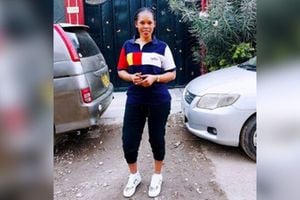African print for your feet

What you need to know:
- A quick search on the Web shows that love for African fabrics and prints was on the New York, London, Paris, and Milan runways a year ago. The Spring-Summer 2012 collections of the US Boxing Kitten and UK’s Burberry did a great job in promoting these fabrics.
Fabric shoes have became king on the local fashion accessories scene. Designers are creating shoes covered with kitenge, kanga, Maasai blanket, and kikoy to capture the insatiable market for all things African print.
In a market dominated by beaded leather sandals, this is a welcome break. It is a new and exciting frontier in Kenyan footwear and it seems the idea has been simmering since last year.
“Africans or Kenyans particularly are embracing fashion and new trends. There is that inner knowledge that the shoes are local and people love that. Plus the fact that African print — call it kitenge or Ankara — is part of our culture is the punch line,” says Tony Opot, one of the designers/founders of Zeynabally, a local footwear brand.
He adds that in the past six months, the uptake of the basic African fabric shoes has increased tremendously. People still love their Western-style clothes and with African accessories, they can easily update their outfits to reflect their culture.
Relying on the vibrancy of the textures, patterns, and colours of the African fabrics, shoe designers like Emo Rugene of Afros (African Slippers), Zeynab Ali and Tony Opot of Zeynabally, and Ephy Maina’s KenyaNdula have taken advantage of the fact that no two pairs will look alike due to the availability and variety of the fabrics.
“I wanted to make an everyday shoe that Kenyans can wear and still be fashionable and comfortable. African fabrics are distinctive,” says Emo, who began his Afros (African Slippers) footwear brand last May, “Africa is the future. We are tired of copying the West. It’s time we created our own identity.”
A quick search on the Web shows that love for African fabrics and prints was on the New York, London, Paris, and Milan runways a year ago. The Spring-Summer 2012 collections of the US Boxing Kitten and UK’s Burberry did a great job in promoting these fabrics.
So it was natural progression for designers to take the cue and begin making accessories using African print. Zeynabally’s main focus is on Ankara glamourised footwear and bags.
The aim of Zeynabally is to help the modern-day woman or man to identify with and embrace their culture while at the same time fusing it with style and fashion; both vintage and contemporary. The designers want to empower Kenyans with the trappings to do this with elegance and/or vibrant playfulness.
“We are always flexing our creative muscles to come up with fresh new ways to dress up people so that the African element is not left out for just particular occasions but is embraced a lot more on a day-to-day basis. ‘Add a little more African to your closet and shoe rack without over doing it’, we always say at Zeynabally,” says Zeynab. This fever has caught on and now most fashion designers whose work features an accessory line have added these shoes. Thus, competition has increased and this is a good thing. What about the risk of becoming complacent and repeating the same boring designs while forgetting about innovation?
“I’m working on developing something different. I want my shoes to stand out and not be ordinary. With the increased competition, I need to evolve,” says Emo.
Closet 49 is an online fashion store, stocks shoes from Dishol, Tropical Muse, Chulala Fashions, and KenyaNdula.
Sera Kanyua, one of the store’s owners, argues that if the designers lower their prices, then it will make it easier for Closet 49 to sell their shoes while maintaining quality.
She raises the issues of standards and quality, saying that sometimes a pair can be done well but the next one is poorly done. The finishing is also wanting and this means that the shoe gets worn fast, disappointing the customer who has paid a high prize for the product.
“I think designers need to find a balance between price and quality. The price has hindered full penetration into the local market. When we show the shoes, people show a lot of interest, but they have to save up to buy.
Then there is the influx of cheap Chinese shoes and the slightly cheaper Bata ones that distract the buyer,” she says.
Emo admits that making shoes is not easy as each pair has to be detailed and handcrafted. Although he sources the material locally, it takes one day to make a pair. His shoes range between Sh2,000 and Sh6,000 a pair, depending on the material.
The most popular design are ballet flats because they are easy to make. Zeynabally have mastered the skill of making shoes with heels. This has to be done right to prevent broken ankles and embarrassing situations of heels snapping off.
Although the shoes are in style now, the fashion designers know the fickle nature of fashion.
“I know fashion comes and goes and these shoes will go out of fashion inevitably. Our new collection will have a bit of African print blended with other fabrics. However, African print has never really died; it only withers for a while, then bounces right back,” says Tony.




